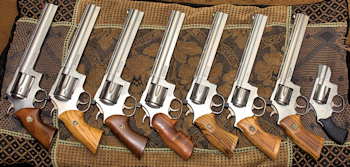Supporter

Moderators
January 24, 2009
 Offline
OfflineRevolver cylinders will have a "shoulder" at the front of each chamber. It's not tapered, but an actual straight shoulder or ridge. I know there's a better term, but my brain can't recall it today. The shoulder is positioned right where the mouth of the brass case is, when you slide a round into the chamber.
The shoulder is positioned right where the mouth of the brass case is, when you slide a round into the chamber.
Supporter
Range Officer

Range Officers
May 2, 2009
 Offline
OfflineCharger Fan said:
Revolver cylinders will have a "shoulder" at the front of each chamber. It's not tapered, but an actual straight shoulder or ridge. I know there's a better term, but my brain can't recall it today.
The shoulder is positioned right where the mouth of the brass case is, when you slide a round into the chamber.
There is also a slight constriction at the face of the cylinder holes--if you try to slip a bullet in from the front you will see how tight it is. On a revolver designed for accuracy/match, this is a critical finishing area.
SHOOT
Supporter

Moderators
January 24, 2009
 Offline
OfflineSHOOTIST357 said:
There is also a slight constriction at the face of the cylinder holes--if you try to slip a bullet in from the front you will see how tight it is. On a revolver designed for accuracy/match, this is a critical finishing area.
SHOOT
Are you saying it does have a taper, then? I don't have anything to measure that with, so maybe I misspoke. Using my micrometer eyeball, it looks straight...does that count?
Range Officer

Range Officers

Dans Club
February 28, 2009
 Offline
OfflineSupporter
Range Officer

Range Officers
May 2, 2009
 Offline
OfflineHere you go--this is better/faster than any of us explaining it.
http://www.gunblast.com/Brownells_Reamer.htm
SHOOT
Supporter

Moderators
January 24, 2009
 Offline
Offlinezoommb said:
Not a taper, just reduced diameter beginning at the point where the front of the case should seat and going forward from there. If you look into the chamber from the back you will see the ridge. It's approximately the thickness of a cartridge case wall.
-Mike
Ok, that's better. I was thinking correctly, then.
Supporter

Moderators

Dans Club
February 22, 2009
 Offline
OfflineAs Shoot said, this is a critical dimension, particularly when shooting lead bullets. I check all my cylinders with a pin guage. The dimension should be the same on all throats and the throats should be just slightly larger (.001-.002) than the bore diameter. Otherwise you could experience leading issues. It's not as important when firing jacketed bullets.
The issue at hand is bullet obturation. Lead bullets need to completely seal the gas, in the bore, behind the bullet. Otherwise there is lead cutting that will leave streaks in the bore. To complicate matters, leading can also be caused by poor lube, amount of lube, velocity, bullet hardness, etc...
That's why I cast my own- I don't enjoy sanity; its not normal.
Best Regards, Ron
Technically, the glass is always full; half liquid, half air....
1 Guest(s)

 Register
Register Log In
Log In Home
Home




